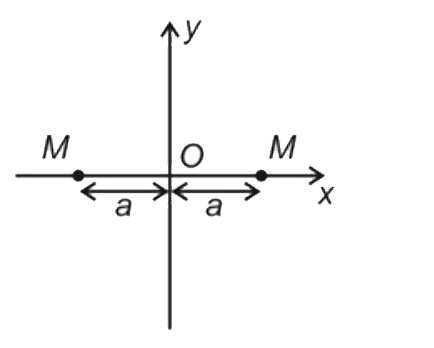Two point masses m are kept r distance apart. What will be the potential at 0.25r distance from any one mass towards the other mass ?
The correct Answer is:−16Gm3r
To find the gravitational potential at a point located 0.25r from one mass towards another mass, we can follow these steps:
Step 1: Understand the Setup
We have two point masses, both of mass m, separated by a distance r. We need to find the gravitational potential at a point P which is located at a distance of 0.25r from one of the masses (let's call it mass 1) and 0.75r from the other mass (mass 2).
Step 2: Write the Formula for Gravitational Potential
The gravitational potential V due to a point mass m at a distance d is given by the formula:
V=−Gmd
where G is the gravitational constant.
Step 3: Calculate the Potential Due to Mass 1
The distance from mass 1 to point P is 0.25r. Therefore, the potential V1 at point P due to mass 1 is:
V1=−Gm0.25r=−Gm14r=−4Gmr
Step 4: Calculate the Potential Due to Mass 2
The distance from mass 2 to point P is 0.75r. Therefore, the potential V2 at point P due to mass 2 is:
V2=−Gm0.75r=−Gm34r=−4Gm3r
Step 5: Combine the Potentials
The total gravitational potential V at point P is the sum of the potentials due to both masses:
V=V1+V2=−4Gmr−4Gm3r
Step 6: Simplify the Expression
To combine these fractions, we need a common denominator. The common denominator for r and 3r is 3r:
V=−12Gm3r−4Gm3r=−12Gm+4Gm3r=−16Gm3r
Final Answer
Thus, the gravitational potential at point P is:
V=−16Gm3r
We have two point masses, both of mass m, separated by a distance r. We need to find the gravitational potential at a point P which is located at a distance of 0.25r from one of the masses (let's call it mass 1) and 0.75r from the other mass (mass 2).
The gravitational potential V due to a point mass m at a distance d is given by the formula:
V=−Gmd
where G is the gravitational constant.
The distance from mass 1 to point P is 0.25r. Therefore, the potential V1 at point P due to mass 1 is:
V1=−Gm0.25r=−Gm14r=−4Gmr
The distance from mass 2 to point P is 0.75r. Therefore, the potential V2 at point P due to mass 2 is:
V2=−Gm0.75r=−Gm34r=−4Gm3r
The total gravitational potential V at point P is the sum of the potentials due to both masses:
V=V1+V2=−4Gmr−4Gm3r
To combine these fractions, we need a common denominator. The common denominator for r and 3r is 3r:
V=−12Gm3r−4Gm3r=−12Gm+4Gm3r=−16Gm3r
Thus, the gravitational potential at point P is:
V=−16Gm3r
Topper's Solved these Questions
- GRAVITATION Book:AAKASH INSTITUTE ENGLISHChapter:GRAVITATION Exercise:ASSIGNMENT SECTION -A (Objective Type Questions (one option is correct))
Explore 50 Videos
- GRAVITATION Book:AAKASH INSTITUTE ENGLISHChapter:GRAVITATION Exercise:ASSIGNMENT SECTION -B (Objective Type Questions (one option is correct))
Explore 20 Videos
- GRAVITATION Book:AAKASH INSTITUTE ENGLISHChapter:GRAVITATION Exercise:ASSIGNMENT SECTION - D (ASSERTION-REASON TYPE QUESTIONS)
Explore 15 Videos
- ELECTROSTATIC POTENTIAL AND CAPACITANCE Book:AAKASH INSTITUTE ENGLISHChapter:ELECTROSTATIC POTENTIAL AND CAPACITANCE Exercise:ASSIGNMENT SECTION - D
Explore 9 Videos
- KINETIC THEORYBook:AAKASH INSTITUTE ENGLISHChapter:KINETIC THEORYExercise:EXERCISE (ASSIGNMENT) SECTION - D Assertion - Reason Type Questions
Explore 10 Videos
Similar Questions
Two identical spherical masses are kept at some distance. Potential energy when a mass m is taken from the surface of one sphere to the other
View SolutionTwo point masses m and 4 m are seperated by a distance d on a line . A third point mass m0 is to be placed at a point on the line such that the net gravitational force on it zero .

The distance of that point from the m mass is
View SolutionTwo bodies of masses m and 4m are placed at a distance r. The gravitational potential at a point due to mass m on the line joining where gravitational field is zero
View SolutionTwo point masses m and 3m are placed at distance r. The moment of inertia of the system about an axis passing through the centre of mass of system and perpendicular to the joining the point masses is
View SolutionTwo point masses M are kept fixed on the x-axis at a distance a from the origin, another point mass m is moving in a circular path of radius R (in y - z plane) under the influence of gravitational force of attraction, then speed of m will be (Assume no forces are acting on m other than the gravitational forces by two M)

View SolutionTwo bodies of masses m1 and m2 are placed distant d apart. Show that the position where the gravitational field due to them is zero, the potential is given by, V=−Gd(m1+m2+2√m1m2)
View SolutionIn a free space a rifle on mass M shoots a bullet of mass m at a stationary block of mass M distance D away from it . When the bullet has moved through a distance d towards the block the centre of mass of the bullet − block system is at a distance of :
View SolutionTwo particles of mass M and 2M are at a distance D apart. Under their mutual force of attraction they start moving towards each other. The acceleration of their centre of mass when they are D/2 apart is :
View SolutionTwo bodies of mass M and 4M kept at a distance y apart. Where should a small particle of mass m be placed from M so that the net gravitational force on it is zero
View SolutionTwo particles of masses m and M are initially at rest at an infinite distance apart. They move towards each other and gain speeds due to gravitational attraction. Find their speeds when the separation between the masses becomes equal to d.
View Solution